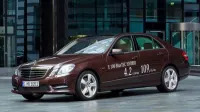Mercedes bringing two E-class hybrids, one diesel-powered, to Detroit *UPDATE

The diesel-burning E300 Bluetec Hybrid is obviously the more efficient of the two. If numbers reported by AutoBild are accurate, it will get 56 miles per gallon (on the European scale, probably something like 45 mpg here) while the standard petrol-powered E400 Hybrid will manage only 27 mpg (U.S. scale). Both vehicles will use a 0.8-kWh lithium-ion battery and a 7G-Tronic transmission.
Mercedes already has the S400 Hybrid and the news that Mercedes would produce the E300 Bluetec Hybrid was confirmed back in May. Even though AutoBild’s report says we’ll see the diesel-hybrid debut in Detroit, we still don’t have any more of an inkling that we’ll see it for sale anywhere outside of Europe. We’ll be on the lookout for complete details from Cobo Hall in the very near future.
*UPDATE: M-B has released official information on the cars, which we’ve pasted after the jump.
Stuttgart, Dec 20, 2011
Mercedes-Benz E 300 BlueTEC HYBRID: 4.2 l of diesel/100 km, 109 g of CO2/km
Mercedes-Benz E 400 HYBRID: fuel economy of 27 mpg
More torque and performance without compromising on space and usable boot volume
Available in Saloon and Estate versions (E 300 BlueTEC HYBRID)
Modular hybrid concept using lithium-ion batteries
Reduction in CO2 emissions and fuel consumption of around 15 percent compared with the E 250 CDI
Impressive driving experience thanks to start/stop function, regenerative braking, boost effect, purely electric motoring and “sailing” function
Mercedes-Benz is opening a new chapter in its brand’s core segment and at the same time setting new standards for luxury-class business vehicles: the E 300 BlueTEC HYBRID, available as a Saloon and Estate, impresses with new record values when it comes to efficiency. It boasts exemplary consumption levels (4.2 l/100 km[1]) as well as impressive performance: the 4-cylinder diesel engine of the E 300 BlueTEC HYBRID has 150 kW (204 hp) and 500 Nm. Combined with an electric motor producing 20 kW and 250 Nm, this results in a coherent overall concept. The E 300 BlueTEC HYBRID is the most economical luxury-class vehicle in the world.
The V6-cylinder petrol engine in the E 400 HYBRID produces 225 kW (306 hp) and 370 Nm, and is also supplemented by a further 20 kW and 250 Nm from the electric motor. The consumption figures based on the American CAFE standard are: City 24 mpg, Highway 31 mpg, Combined 27 mpg.
“With these two E-Class models we are now continuing our comprehensive hybrid offensive. The modular technology opens up a quick way for us to complement other model series with hybrid models”, explains Professor Dr. Thomas Weber, Daimler Board Member for Group Research and Head of Mercedes-Benz Cars Development. “With a clear focus on the different requirements of global markets, we are able to offer precisely the models which our customers want. The E-Class hybrids provide a clear reduction in consumption as well as a very impressive driving experience: they represent hybrid motoring at the premium level.”
The new models do not require their passengers to have to compromise when it comes to space, however, whether in terms of the interior or the luggage compartment. And there are also additional benefits to the intelligent modular hybrid concept, which represents a comprehensive enhancement of the Mercedes-Benz S 400 HYBRID which has advanced to the position of clear market leader since 2009: no changes to the vehicle body are required, the hybrid module is both flexible and modular, thus allowing its use in other model series, and in addition to diesel and petrol variants there will also be right-hand drive variants. Meanwhile, the extra cost involved here is only moderate. The new hybrid models will be celebrating their world premiere at the Detroit Motor Show (14 to 22 January 2012) and will appear on the market over the course of the year. The E 300 BlueTEC HYBRID is initially planned to be launched on the European market, while the E 400 HYBRID will be made available on the American market first, followed by other countries such as Japan and China later.
Highlights of the E 300 BlueTEC HYBRID at a glance:
Compact, intelligent and modular hybrid concept: no changes to the body of the base vehicle are necessary
Also available as an Estate
Space, safety and comfort remain unchanged
No compromises in terms of space, safety and comfort
Significant increase in comfort with start/stop operation; noiseless start, complete climatic comfort
Top marks for consumption in the luxury-class business vehicle segment: 4.2 litres/100 km, 109 g CO2/km
Part of the intelligent downsizing strategy of Mercedes-Benz: increase in the engine output of the E 300 BlueTEC HYBRID with 150 kW + 20 kW electric motor/500 Nm + 250 Nm, compared with the E 250 CDI (150 kW/500 Nm), positioning it at the same level as the E 300 CDI (170 kW/540 Nm)
Fuel savings of around 15 percent compared with the E 250 CDI – even in actual road traffic conditions
Impressive hybrid driving experience (start/stop function, regenerative braking, boost effect, purely electric motoring and “sailing” function)
Highlights of the E 400 HYBRID at a glance:
Compact, intelligent and modular hybrid concept: no changes to the body of the base vehicle are necessary
No compromises in terms of space, safety and comfort
Significant increase in comfort with start/stop operation; noiseless start, complete climatic comfort
Consumption combined (CAFE): 27 mpg
Part of the intelligent downsizing strategy of Mercedes-Benz: increase in the engine output of the E 400 HYBRID by some 20 kW and 250 Nm thanks to the electric motor
Impressive hybrid driving experience (start/stop function, regenerative braking, boost effect, purely electric motoring and “sailing” function)
[1] All consumption and performance figures are preliminary figures based on the Saloon model, as at December 2011




